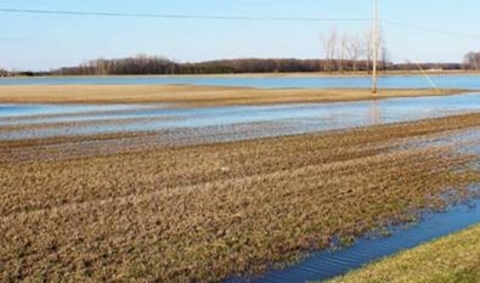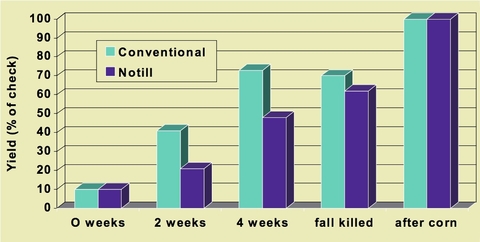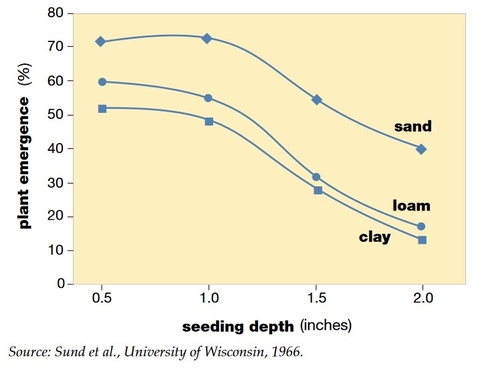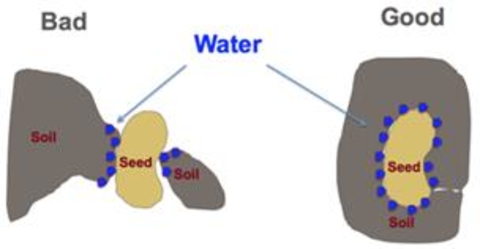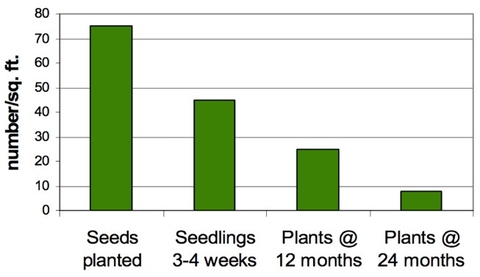Quick facts
Select fields with deep, well-drained soils.
Fertilizer soils to mitigate soil nutrient deficiencies.
Spring seed into smooth yet firm seedbeds with at least 13 pounds of pure live seed per acre.
Plant seeds from 1/4 to 3/4 inch deep.
Control weeds with herbicide or companion crops.
Check for herbicide carryover from previous crop use.
Management strategies
Because alfalfa production spans several years, it’s important to start off with the most productive stands possible. In addition, seeding year forage yields can provide a revenue stream to off-set establishment costs. Here, we’ll cover management strategies for optimal alfalfa establishment. These are also provided in the Alfalfa Management Guide:
Field selection.
Fertility management.
Seeding alfalfa.
Seeding dates.
Field preparations and seeders.
Seeding depth.
Seed-to-soil contact.
Weed control and companion crops.
Seed quality and coatings.
Seeding rates.
Checking for herbicide carryover
Variety selection
Field selection
Site selection is important because alfalfa prefers well-drained, deep soils. Under ideal growing conditions, alfalfa roots can explore soils to depths over 20 feet.
When selecting fields, try to avoid hilltops, shallow and highly eroded soils and fields with low spots where water is known to pool (Photo 1). Wet soils not only reduce diffused oxygen (O2 (g)), but also benefit diseases and increase the risk of ice sheeting.
In addition to locating well-drained, deep soils, following alfalfa with newly-seeded alfalfa in the rotation is not advisable due to autotoxicity. Alfalfa produces toxins that reduce germination and impair taproot development. Ultimately, this limits water and nutrient uptake, directly impacting yield and performance (Figure 1).
Soil fertility management
After selecting the field, soil sampling and analysis will identify soil nutrient deficiencies. Because alfalfa has both initial and annual fertilizer needs, yearly soil sampling will provide detailed information on available nutrients.
Fertility management ensures good stands and vigorous growth during the establishment years, while increasing productivity and persistence throughout the production years. Several parameters and nutrients are critical for optimal stand health, although here we’ll focus on soil pH, potassium, phosphorus, and sulfur.
Soil pH
Maintaining soil pH between 6.5 and 7.0 is extremely important because nutrients are most available to alfalfa roots within that range. In addition, Rhizobia microorganisms responsible for biological nitrogen fixation are most active in the pH range.
Because buffering soil pH can take time, soil test and apply and incorporate lime (calcium carbonate) 6 to 12 months prior to alfalfa seeding based on soil reports. This will allow adequate time for the lime treatment to neutralize soil acidity. Typically, you won’t need to re-apply lime during alfalfa’s lifecycle.
Phosphorus, potassium, and sulfur
Soil phosphorus (P), potassium (K), and sulfur (S) levels should be assess before seeding and annually throughout the alfalfa lifecycle. Large amounts of P and K are removed with harvest (Table 1). Maintaining non-limiting levels of these nutrients will improve alfalfa stand establishment, yield and persistence.
Reduction in atmospheric deposition of S due to reduced industrial emissions has led to S deficits in soils containing low organic matter levels. Annual applications of as much as 25 pounds per acre of S are needed on sandy, low organic matter soils. S can be supplied by manure or fertilizers. See Fertilizing alfalfa for more information.
Table 1. Pounds of nutrient removed per ton of alfalfa produced.
| Nutrient | Nutrient removal |
|---|---|
| pounds removed per ton of alfalfa | |
| Phosphorus (P) | 6 |
| Phosphate (P2O5) | 14 |
| Potassium (K) | 48 |
| Potash (K2O) | 58 |
| Sulfur (s) | 6 |
Seeding alfalfa
Alfalfa can be successfully seeded in spring or late summer in Minnesota.
Spring seeding dates of April 15 to May 15 are recommended for most of Minnesota. However, north of St. Cloud, later planting dates (May 1 to 30) are advised. Recommended late-summer seeding dates are August 1 to September 1 for southern Minnesota and July 20 to Aug. 1 for northern Minnesota. Alfalfa seedlings should have a minimum or three trifoliate leaves before a killing frost (24F) occurs, so seeding beyond September 1 is not recommended.
Both seeding dates have pros and cons (Table 2).
Table 2: Pros and cons of spring and summer alfalfa seeding dates
| Seeding date | Pros | Cons |
|---|---|---|
| Spring | More soil moisture, enhanced germination and cooler temperatures. Yield potential from longer growing season. |
Weed control required, excessively wet springs |
| Summer | Herbicides typically not needed. Best time to seed alfalfa-grass mixtures |
Lack of available soil moisture, sclerotinia crown rot may be prevalent, need six to seven weeks of growth to survive the winter |
Proper seedbed preparation is essential for providing adequate seed-to-soil contact and controlling perennial and annual weeds. Many establishment failures can be avoided by using primary tillage (chisel plowing) followed by disking and secondary tillage (i.e., smoothing operation) in conjunction with cultipacker.
Ideal seed-bed conditions should be smooth, firm and clod-free with minimum residue for optimal seed placement using drills and brillion seeders. When walking on soil prior to planting, the heel of your shoe shouldn’t sink more than 1/2 inch into the soil. If it does, then use a cultipacker to firm the surface or a press wheel drill with depth control.
With a proper seedbed preparation, the choice of planter type doesn’t impact alfalfa yield.
Once you’ve prepared the field and properly calibrated the seeder, the number one cause of poor stand establishment is improper seeding depth. Generally, alfalfa should be seeded from 1/4 to 1/2 inch deep on medium and fine-textured soils and 1/2 to 3/4 inch deep on sandy soils.
Seed that is deposited on the surface and not incorporated will germinate if rainfall occurs, but will die because its root system has not penetrated the soil. In contrast, seed that is planted too deep will germinate but the seedling will be unable to reach the soil surface.
Seeding depth is an issue when seeding with a drill. There’s a direct relationship between stand establishment and seeding depth. Sandy soils are a bit more forgiving, but it’s a good idea to limit planting depth to a 1/2 inch regardless of soil type (Figure 5).
The goal of providing a proper seedbed is to ensure good seed-to-soil contact. Because most forage seeds must absorb more than their own weight in water, good seed-to-soil contact is essential for uniform emergence.
Soil particles hold the water needed for germination. The more particles in direct contact with the seed, the quicker the seed can absorb water and germinate (Figure 3).
There are two approaches to weed control when seeding alfalfa:
Seeding with a companion crop
Companion crops, such as oats, barley, and wheat, are a traditional approach to establish alfalfa in the spring. They suppress weeds, reduce soil erosion, and provide forage, grain and straw. Small grain companion crops can suppress growth of alfalfa seedlings; to reduce competition, small grains should be seeded at only one bushel per acre and harvested at boot stage before grain is formed. After the companion crop is harvested, it may be possible to harvest alfalfa once before early September.
Direct seeding without a companion crop
Direct seeding involves planting without a companion crop and using a herbicide for weed control. Because competition from weeds and companion crops is reduced, alfalfa establishment and seeding year alfalfa forage yields are increased. Direct-seeded alfalfa should be harvested about 60 days following seeding and additional harvests taken before early September.
Seed quality
Alfalfa seed should have a high germination rate (>90%) and be free of weed seeds and other materials. Some bags of alfalfa can have as much as 10 to 20% hard seed that delays germination, but this level of hard seed has no effect on stand establishment. Purchasing certified seed provides the greatest assurance of seed quality.
Seed coatings
Most alfalfa seed is coated to provide Rhizobium, which is required for nodulation, and fungicides for seedling disease control. These seed coatings typically add about 10% to the weight of a seed. Additions of other types of coatings that provide nutrients or growth promoters in a clay base have not been shown to provide benefits. In addition, they can add over 30% to the weight of a seed, so that purchase of a 50 pound bag of seed with 100% germination will only have 35 pounds of pure seed.
Seeding rates should be adjusted based on pure live seed content. Pure live seed is the seed you can expect to germinate (including hard seed). An example calculation for seed that has 90% germination and two levels of coating is provided:
For a 10% weight seed coating, multiply the 90% pure seed times 90% germination to equal 81% pure live seed. To achieve a seeding rate of 15 pounds per acre pure live seed, 18.5 pounds of alfalfa seed would be needed.
For a 30% weight seed coating, multiply 70% pure seed with 90% germination to equal 63% pure live seed. To achieve a seeding rate of 15 pounds per acre pure live seed, about 24 pounds of alfalfa seed would be needed.
Recommended rates
Seeding rates should be between 12 and 15 pounds per acre. Prescribed seeding rates are designed to provide several times the seed needed to achieve optimal yield under ideal growing conditions.
Seeding rates about 15 pounds per acre have no positive impact on yield (Table 3). A seeding rate of 12 to 15 pounds per acre will provide 25 plants per square foot during the first production year, assuming best management strategies were observed. Even though increased seeding rates have no impact on yield (assuming ideal conditions), planting extra seed can provide insurance to high seedling mortality in years when cool, wet weather persists (Figure 4).
Table 3: Effect of seeding rate on first-year alfalfa dry matter yields
| Seeding rate | Dry matter yield |
|---|---|
| 12 pounds per acre | 3.4 tons per acre |
| 15 pounds per acre | 3.6 tons per acre |
| 18 pounds per acre | 3.6 tons per acre |
Check for herbicide carryover
Before seeding alfalfa following corn, soybean, or wheat, review the herbicides that were used for these crops. Some herbicides can carry-over and affect alfalfa establishment. Herbicides have evolved to include residual chemistry to target weeds with resistance to commonly used herbicides such as glyphosate. Therefore, it's important to read rotational restrictions on herbicide labels to determine the number of months required before alfalfa planting is allowed following that herbicide application.
Variety selection
Select high yielding alfalfa varieties with adequate winterhardiness and disease resistance for long-term profitability of the crop. While we have no evidence of significant differences in seeding year establishment or yields among varieties, varieties should be selected for long-term stand performance. Variety traits are described in the Alfalfa Variety Leaflet. Consult local seed dealers for yield results before selecting a variety.
Reviewed in 2023


